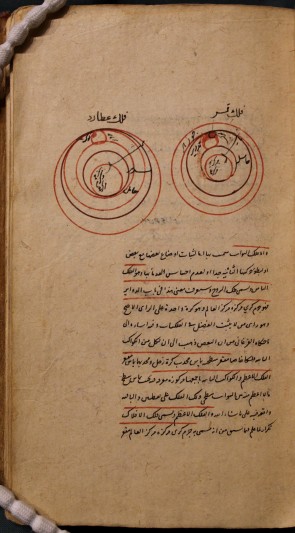Richard Foster, Fellows’ Librarian and Keeper of Collections, writes: Qâdi Zâda Al-Rûmî (1364–1436) was a Turkish astronomer who worked at the observatory in Samarkand, under the direction of Ulugh Beg (d. 1449). He made an important contribution to the flowering of Arabic science in Timurid Iran as one of the authors of a new star catalogue (the Zīj-i Sulṭānī) and a textbook on arithmetic. The present work, compiled by Qâdi Zâda around 1412, is a commentary on al-Jaghmini’s introduction to astronomy, written in the early thirteenth century and the most widely circulated Arabic treatise on Ptolemaic cosmology.
Qâdi Zâda’s commentary itself became a popular work and many manuscripts survive. The majority of these, however, date from the 17th and 18th centuries. Winchester’s copy is an unusually early example, made within decades of the author’s death. It also stands out for the fine quality of its diagrams in red and black ink. These are largely concerned with the movement of celestial bodies, showing the spheres of the planets, lunar phases and solar eclipses. The text is written in neat, formal Nastaliq calligraphy on polished paper. An early reader has made use of the ample margins to make annotations. There are several ownership inscriptions and stamps to the endpapers, as well as quatrains of Persian poetry. The red morocco binding is Persian and dates from the early 18th century.
This acquisition enhances the College’s strong collection of scientific books. Among the earliest of these are medieval and Renaissance works from the bequest of William Moryn (d. 1543). Two 18th-century donations, from Charles Scott (1750) and Robert Shipman (1762), brought to the library many key texts of the Early Modern period, including first editions of Kepler, Newton and Hooke. Two items at Winchester provide particularly interesting comparisons with Qâdi Zâda’s work: a fifteenth-century manuscript of Roger Bacon’s Opus Maius, and an early printed edition of Sacrobosco’s De Sphaera Mundi with Peuerbach’s Theoricae Novae Planetarum (Venice, 1490). These works draw on many of the same classical sources, and include illustrations of some of the same astronomical phenomena, as the Arabic manuscript. Together, they form an invaluable teaching resource for showing the exchange of scientific ideas between Eastern and Western cultures in the middle ages.
In 2021, the manuscript will go on public display as part of a temporary exhibition in the College museum. Further images and detailed information are available via Winchester’s online collections database.
